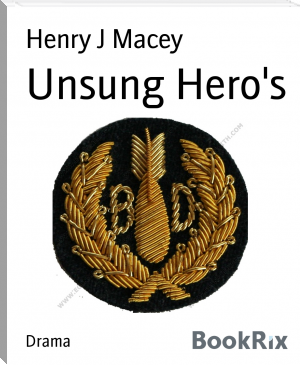Unsung Hero's, Henry J Macey [classic novels .TXT] 📗

- Author: Henry J Macey
Book online «Unsung Hero's, Henry J Macey [classic novels .TXT] 📗». Author Henry J Macey
UNSUNG HEROES:
AN UNTOLD, UNVERIFIED TALE OF HEROISM
Throughout my life, I have heard stories of brave men and women doing acts of valour on and off the fields of battle. Many of these were related to those sitting around campfires, drinking from cans of beer, as the tales of old comrades – some who had passed on, others who had moved on – were remembered. These stories were told to like-minded fellows, some never to be written down, never to become widely known by those outside the circles of military life.
Some tales have been made into blockbuster movies, some into widely-read, best-selling books. I have seen first-hand some brave soul dive into stormy seas to rescue a stranger in distress but never had it written down or told. There are many stories of bravery in the skies during the Battle of Britain in the dark days of World War II, the bravery that was witnessed by those on the ground who could only stand there and shake their fists at the black crosses that brought death and destruction to the cities of England.
Tales exist that describe heroism acted out in the face of overwhelming danger, of men saving men with bullets flying and shells bursting all around them. Men putting themselves in danger for the sake of their comrades, men going one extra step beyond for their friends. Then there are the unknown heroes, never given the accolades they deserve. The men and women, that worked in the shadows to achieve an outcome that would not have been possible without them.
What about the brave men who sat on exploded bombs, working with delicate care to defuse them, not knowing if their next move would be their last? With no manual to guide them, they learned from others’ mistakes, aware that “click” would be the last sound they would ever hear if they did something wrong. Some of their stories told as bit parts, small cuts in bigger wartime films, which passed almost unnoticed by the movies’ audience. Unless they knew of such men in the first place, and of the mental strain and sleepless nights, such men suffered, their brief presence in the film was almost meaningless.
I was one of those who wanted to learn the skill of defusing bombs but never did pass the written tests. So never had to babysit a sleeping monster, fearing at any moment it could wake from its slumber, and I would have mere seconds to put it back to sleep or I would be the one sleeping for the rest of eternity. This had been the fate of the poor souls; these sleeping monsters took to an early grave, during the terrible days during the forties after the bombs had fallen. Innocent young souls just starting out in life that would be searching for their dolls and toys in the rubble of their bombed homes, only to be blasted into oblivion by the sleeping monster lying in wait for the unwary.
These monsters were the terror weapons dropped with normal, contact-explosion bombs, and that lay sleeping for hours after the plane that dropped them had flown away. Their delaying devices timed in such a way that they would not explode until the rescue squads had started searching for survivors of the bombs dropped hours before. Their fiendish purpose was to kill rescue parties of police, firefighters, ambulance crews, and volunteers. Bring terror to the hearts and minds of those hoping to help the trapped and injured victims of the bombings.
Chapter two A Brief History
Chapter Two – A Brief History
In February 2018, an unexploded World War II bomb found near London City Airport had to be detonated. Just how common are these types of discoveries?
Since 2010, the Ministry of Defence (MoD) disclosed its involvement with having to make 450 German WW2 bombs safe – that averages out to 60 per year. Unfortunately, I have been unable to find pre-2010 data about this, so I am unable to say if the rate of discovery has risen or fallen in the years since 1945. In addition to the lack of data, it seems these figures to do not take into account the involvement of private companies.
Aside from the military’s work to neutralize these devices, a job that has been supported by the police, fire, and ambulance services, unexploded items including not only bombs, but grenades and mortars as well, are also handled by private individuals – usually those with a military background – and by a few specialist companies.
Because so many are involved, establishing an exact count of the items dealt with each year is difficult, especially since the data is not officially collected and collated from the many sources. Little difference exists between a two-inch 1940s mortar and one built in the 1980s, other than a bit more rust on the former. Establishing the portion of overall ordnance that came from World War II is therefore problematic. For example, some of the devices discovered could have been from times that are more recent and may have originated from training exercises.
Only a small percentage of these discoveries end up on the news, and those that do appear in the headlines tend to be the much larger devices that have made evacuations of the surrounding areas necessary. With most of the high explosive World War II ordnance buried so deep, its discovery made only by construction workers, making it unlikely that a member of today’s public will stumble across one.
The German WWII bombing campaign tended to focus on strategic locations. This meant that major UK cities or areas with important features, like railway junctions or ports, were key targets. No record currently exists of how many of these discoveries are WWII timed-delay explosive devices, or, as I call them, “Sleeping Monsters.”
Chapter Three– Personal Observations.
Chapter Three – Personal Observations
I learned of these monster weapons during a lecture about explosive devices given by a successful bomb disposal operative. At the time, I was eighteen and in the Navy. This expert had dealt with many unexploded ordnances during his fifteen years as an operative – we were amazed he was still alive to tell us about them.
Like others who had survived this job, he had learned not to make the same mistakes as those who had died; with all bomb disposals done with radio contact, each step of the operation recorded for future reference in case the operative did not survive. These recordings guided him and others like him to disarm the weapon successfully.
We saw the tools they had developed to render the device safe. In addition, how to detect booby traps, if they existed, they showed us films of bombs being dismantled and defused, and how they were safely disposed of. Visual aids used in the lecture included actual parts of percussion detonation bombs that he used to demonstrate how, because they had not landed correctly, they had not gone off.
Some had landed on their tails after a glancing blow off a sloping roof had sent it spinning. These bombs had to have the inspection pate and the detonation mechanism removed, to make them safe, a tricky operation if it had not landed with the plate uppermost. A good number of these bombs found in water-filled holes after the firefighters had doused the flames in a building demolished by other bombs.
They also gave us dummy bombs to operate on, After seeing the films, though, it didn’t feel real to me, not with the bomb on a workbench at the right height to work on, the inspection plate conveniently on top, with shiny screws to undo a mechanism you knew was a harmless, practice bomb.
When we returned to the classroom after lunch, the lecturer put an old, battered suitcase on his presentation table. Pulling several mechanical devices from it, he sounded more serious now as he explained where these devices had come from and why he had them. The five clockwork mechanisms had, he told us, come from one-thousand-pound bombs called landmines, and that had failed to go off.
At first, he said, they had thought the devices had merely malfunctioned – until they came across even more bombs with the same “defect.” An unbelievable theory began to circulate among the members of the bomb disposal teams, a theory that they could not readily confirm. Which would indicated sabotaging the mechanisms during their assembly. As in every device, one wire had not been stripped back to make a strong contact necessary to complete the firing circuit.
Only after the war ended did the pieces of this puzzle fall into place as tales of what went on in Germany, before and during the war told to the men who were still digging up unexploded bombs. Our instructor was one of these men, but he had kept the evidence that was responsible for saving many lives. As we looked at that evidence, he told us what they had discovered about the men who had made and disabled the devices.
Chapter Four– A Mystery Solved
Chapter Four – A Mystery Solved
In the years before the war, Germany's ruling party put the German Jews into ghettos and labour camps. They used them for work in the factories and for other manual labour. Skilled workers, like watchmakers metal workers and engineers. Were selected and forced to work in ordnance factories, making the mechanisms to arm bombs as there fell from the planes. In addition, to the clockwork timing devices, that would set the bomb of hours after they had landed.
These men and woman must have been in a state of





Comments (0)